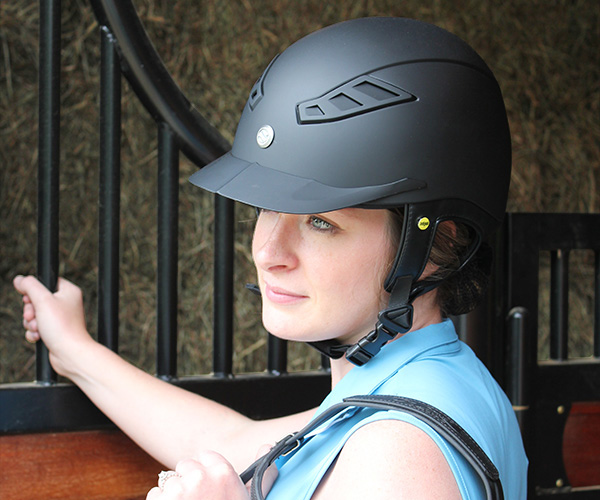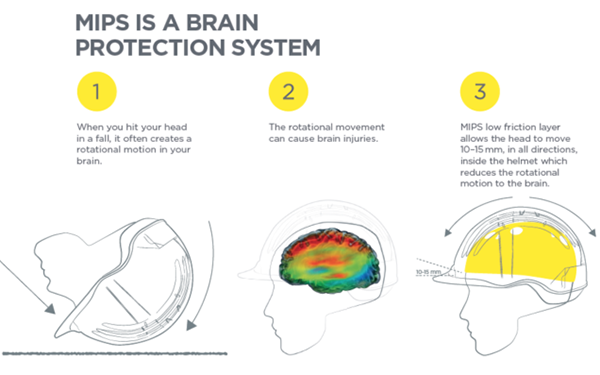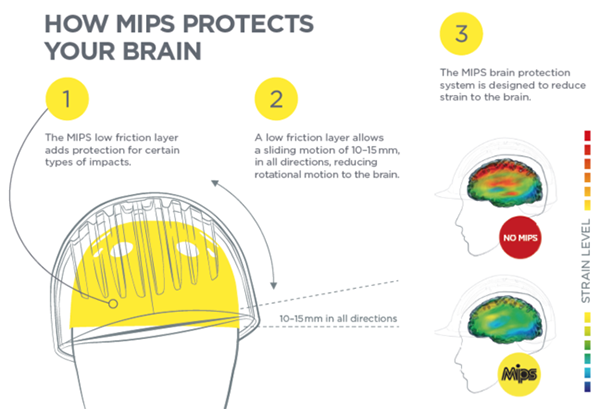
For over a decade, skiers, snowboarders, and bikers have relied on the innovative Multi-Directional Impact Protection System (MIPS) helmet technology to protect them in the event of a crash. Now, this technology has burst onto the equestrian scene with popular equine manufacturers. Trauma Void and Charles Owen are now producing helmets that top the field in both safety and style.
In addition to our inventory of ATSM-SEI certified helmets, we now also carry helmets with MIPS safety technology to offer another layer of protection against concussions and traumatic brain injuries (TBIs). Keep reading to learn more about the benefits of an incorporated MIPS in your helmet.
The Facts
The human body is an engineering marvel, so it should be no surprise that MIPS technology borrows from our own protective layers. When our head hits the ground, our scalp slides on impact to reduce the effects of the crash on the skull and the brain. The scalp can only stretch so much though, and once it has reached its limits, the brain still continues to move. This brain movement may result in breakage of the arteries and veins in the skull, and may cause a brain bleed.
Kate Blanchard, a member of our sales team, explains that MIPS mimics the action of the scalp and protects in a very similar way, while also decreasing the likelihood of brain bleeds. “Unlike traditional helmets, the MIPS helmet has an inner shell that shifts in order to protect your brain. The low friction layer of the MIPS helmet allows a sliding motion, 10-15 mm to be exact, in all directions to reduce the impact effects to the brain.”

The Difference
Most all helmets today are tested for vertical impact. In reality, what is the actual chance of us landing on our heads at a vertical angle? Slim to none. Traditional helmets are designed primarily to pass this testing, with the ability to negate the effects of direct impact. The MIPS technology is designed to offer additional protection against rotational motion transmitted to the brain from angled impacts to the head.
When a layer of MIPS technology is combined with the safety features of modern helmets, like a molded plastic exterior and dense foam padding, the result is a helmet that is able to protect you from every angle.
Extensive research has been performed on these new helmets, both by the helmet manufacturers and independent companies. The results have been extremely favorable. Associate Professor at Folksam (a Swedish insurance company), Helena Stigson, PhD reports that their test indicates, “that there is a link between rotational energy and strain in the grey matter of the brain.” MIPS has been shown to reduce the risk of rotational strain on the head, and it aids in the absorption of the energy so that it does not transfer to the brain.

What It Means For You
When it comes to purchasing MIPS helmets, they will feel very similar to traditional helmets, since the technology really only comes into play in the event of a fall. The specialized layer is embedded between padding, which cushions your head and the EPS (expanded polystyrene) foam. MIPS is particularly effective against falls that are seen at high speeds, such as racing, polo, jumpers, gymkana, and eventing.
The additional technology in the equestrian helmet does not affect the way that it fits. Kate explains that, “the sizing is going to be the size you are in a traditional helmet.” As with any helmet, the shape of your head will also come into play. The Charles Owen helmets are known for fitting oval heads, but the company has recently announced that the MIPS helmet line (the My PS Helmet and the MS1 Pro Jockey Skull Helmet) are available in both oval and round fits to ensure that they fit a wide variety of riders. The Trauma Void EQ3 Helmet and the Trauma Void Lynx Helmet are rounder in shape, with additional padding available so that they are also able to accommodate an oval head shape. To learn more about selecting the right helmet and size for your, refer to our blog post on how to properly fit a riding helmet.
Like all equestrian helmets, MIPS helmets are only able to protect your head for one impact. The impact of a fall will compress the foam and damage the exterior, which still does the brunt of the work in absorbing the shock and preventing injury. Your helmet will need to be replaced after every fall, or every five years – whichever one comes first.
At The Cheshire Horse, we are excited to offer you the newest helmet technology at affordable prices. The members of our friendly sales staff have been highly trained and are always available to answer any questions you may have about MIPS helmets. Browse our complete line of MIPS equestrian helmets here to give your brain and skull an additional layer of protection!

Thank you for talking about MIPs. I happened onto the discussion and Why in the round world would anyone buy a helmet that didn’t have the MIP protection. I can’t believe only Trauma Void and Charles Owens are the only two companies. I currently own the Void and plan to try the Charles Owens. I am hope to find lighter weight and more ventiliation. It is hot in Western Nebraska in the summer!!
Thank you for posting this simple yet good explanation of what MIPS technology can do.
I think the idea behind the technology is great and we need to advance helmet design, especially in our sport.